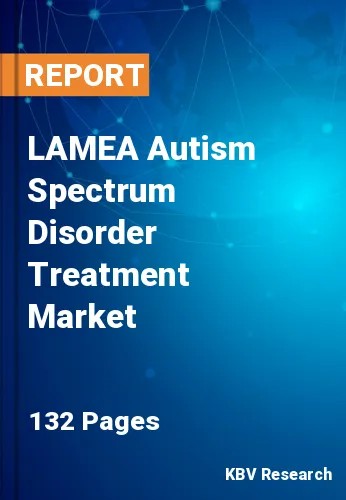The Latin America, Middle East and Africa Autism Spectrum Disorder Treatment Market would witness market growth of 11.9% CAGR during the forecast period (2023-2030).
ASD-related symptoms can appear in children as young as 12 months old and can evolve over time. Due to the clutter's vast range in the type and severity of symptoms, the term "spectrum" is frequently used to refer to autistic clutter. Additionally, the various kinds of ASD are caused by the fusions of a few inherited variants. However, non-inherited features and both frequent and rare inherited variations in genetics play a role in the emergence of ASD. Patients with ASD, according to the DSM-5, struggle with social contact, communication, activities, and nonverbal intelligence. They also exhibit repetitive behavioural patterns.
Patients might benefit from regular behavioral therapy, especially concerning cognitive skills. Positive treatment for these patients has been made possible by improved therapy techniques and public awareness. Additionally, drugs are being developed to treat a variety of emotional and behavioral issues, including anxiety, irritability, aggression, hyperactivity, and depression. It is projected that the study and creation of new medications to treat people with ASD will favorably influence market expansion.
ASD prevalence rates in Latin America vary by country and region. Accurate prevalence data can be challenging to obtain due to differences in diagnostic criteria, access to healthcare, and awareness levels. Some countries have reported prevalence rates ranging from 1 in 500 to 1 in 150 individuals. While progress has been made, challenges remain, including increased access to services, training for professionals, and public awareness campaigns that will aid in reducing stigma and promoting inclusion. Collaboration between government agencies, advocacy organizations, and the international autism community has played a crucial role in advancing autism initiatives in the region. Therefore, owing to all these elements, the market is expected to expand significantly in the coming years.
The Brazil market dominated the LAMEA Autism Spectrum Disorder Treatment Market, by Country in 2022, and would continue to be a dominant market till 2030; thereby, achieving a market value of $46.3 Million by 2030. The Argentina market is anticipated to grow at a CAGR of 12.5% during (2023 - 2030). Additionally, The UAE market would exhibit a CAGR of 11.6% during (2023 - 2030).
Based on Type, the market is segmented into Stimulants, Antipsychotic Drugs, Selective Serotonin Reuptake Inhibitors, Sleep Medications, and Others. Based on Application, the market is segmented into Autistic Disorder, Asperger Syndrome, Pervasive, Developmental Disorder, and Others. Based on Distribution Channel, the market is segmented into Retail Pharmacy, Hospital Pharmacy and Online Pharmacy. Based on countries, the market is segmented into Brazil, Argentina, UAE, Saudi Arabia, South Africa, Nigeria, and Rest of LAMEA.
Free Valuable Insights: The Worldwide Autism Spectrum Disorder Treatment Market is Projected to reach USD 3 Billion by 2030, at a CAGR of 6.2%
The market research report covers the analysis of key stake holders of the market. Key companies profiled in the report include F. Hoffmann-La Roche Ltd., Bristol Myers Squibb Company, Merck & Co., Inc., Novartis AG, Eli Lilly And Company, Pfizer Inc., Johnson & Johnson, Otsuka Pharmaceutical Co., Ltd., Yamo Pharmaceuticals, and Curemark LLC.
By Type
By Application
By Distribution Channel
By Country
Our team of dedicated experts can provide you with attractive expansion opportunities for your business.

